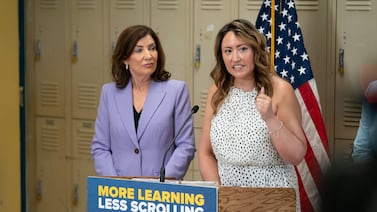A version of this story first appeared on WBEZ Chicago and is republished here with permission.
College decision day is May 1, and high school seniors across Colorado and the country are sorting not just through acceptance letters — but financial aid offers, too.
Students and families rely on these offers, often called award letters, to figure out the affordability of their college options. But unlike other transactions involving big sums of money, like mortgages, the letters are not federally regulated. They look vastly different from college to college and are notoriously hard to understand.
“Some look, frankly, like taxes,” said Samantha Mondro, a college counselor at Chicago Bulls College Prep, a public charter school in Chicago. “And it’s like, ‘What do I add together? What do I subtract? What am I borrowing?’”
More than half of universities leave out important details about how much a student will pay when putting together financial aid award letters, the Government Accountability Office found. Nine out of 10 understate or omit net price, or out-of-pocket costs, and three out of 10 mislabel loans as grants that don’t need to be paid back.
As a senior at a Chicago public high school years ago, Mondro had to navigate this complexity on her own. Like many of the students and families she helps, her parents never attended college so she could not rely on their knowhow.
Now, as part of the college counseling team at Bulls College Prep, “I’m literally assisting the younger version of myself navigate this process, but like times 65 every year, which is really lovely,” Mondro said. “But I wonder what it’s like for students who don’t have a ‘me’ that works with them on a daily basis.”
For students who don’t have a Ms. Mondro in their life, below are steps you can follow to make sense of your financial aid award letters.
(You can fill out this Financial Aid Comparison worksheet, courtesy of Sara Yelich Miller and Green Halo Scholars, as you go.)
1. Calculate the total cost of attendance.
Add up your direct costs and your expected indirect costs:
Direct costs (billed by the college):
- Tuition and fees
- On-campus housing and meals (if not commuting)
Indirect costs (not billed by the college):
- Books
- School supplies
- Off-campus housing and meals (if commuting)
- Transportation
Most universities don’t break down costs or even include the total cost of attendance on award letters, so you may have to hunt this information down on the institution’s website or call their financial aid office.
2. Separate gift aid (grants and scholarships, or “free” money) from loans (“not free” money).
Gift aid does not need to be paid back and may include:
- Federal Pell and state grants
- Federal Supplemental Educational Opportunity Grant
Gift aid does NOT include:
- Federal direct subsidized loans, federal direct unsubsidized loans, and Parent Plus Loans (these need to be paid back)
- Federal work study (this is not guaranteed and will not be available until a student gets a job and is working on campus)
“You don’t get that money upfront,” Mondro said of work study funds. Students often say, “They’re giving me that money,” but she tells them: “Nope, you have to get a job first.”
3. Calculate what you will actually have to pay.
You can figure this out by taking the total cost of attendance and subtracting your gift aid. The result is your “financial gap” or how much you’d have to pay out of pocket with savings, earnings, and loans.
This is crucial because a vast majority of universities do not include or understate the net price, or what you’ll actually have to pay, on award letters, according to the Government Accountability Office.
It’s worthwhile to consider your expenses without indirect costs (books, school supplies, travel), too.
“That way students can see what the bill will be at the start of each semester,” said Sara Yelich Miller, executive director of Green Halo Scholars, which helps students from low-income families in Chicago’s western suburbs get to and through college.
Universities’ estimates of indirect costs may be a lot higher than what a student would actually spend, especially for students used to finding deals on books, school supplies, and travel, Yelich Miller said.
“Illinois State is a great example of this – their indirect costs have like $3,500 in miscellaneous costs, which feels so high and often makes our students think it’s more expensive than what it actually is to go.”
4. Beware of Federal Direct Plus Loans, also called Parent Plus Loans.
These are loans for parents to help their children with the cost of attending college. But they have higher interest rates, fewer protections than federal student loans, and they start accruing interest right away.
Parent Plus Loans “make it really easy for families to take out a massive burden that they might not have the means to pay back,” Yelich Miller said. “And I’ve seen that in my own life. That’s why this work is so important to me. My family took out Plus loans to pay for my education and it’s still a source of contention. We’re still paying it back.”
5. Ask schools for more money.
“The worst thing they’re going to say is no,” Mondro said. “You’re going to have more power with a private school versus a public school that’s very bound by funding that they receive from outside entities, but you could ask, ‘Do you have any additional scholarships,’ or ‘I need $1,000 or $2,000 more to attend this school.’ And some schools will actually find that.”
Yelich Miller recommends using the online tool FormSwift, which helps families write appeal letters to send to financial aid officers.
“Appealing can feel so intimidating, but once you have that letter or language to use, it just becomes an honest conversation,” she said.
6. Make a plan.
Once you calculate your financial gap or what you’ll actually have to pay to a college, “decide if it’s something you can work over the summer to close, or if you can create a payment plan with the bursar’s office,” Yelich Miller said. “Sometimes the plan is, ‘Rule this school out,’ but other times, once we do the math, it’s more realistic than what students expected.”
Lisa Philip covers higher education for WBEZ, in partnership with Open Campus. Follow her on Twitter @WBEZeducation and @LAPhilip.






